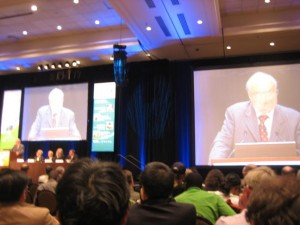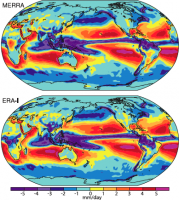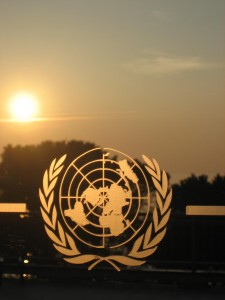A number of us are at the big AGU meeting in San Francisco this week (among 20,000 other geophysicists). We will try to provide a daily summary of interesting talks and posters we come across, but obviously this won’t be complete or comprehensive.
Other bloggers are covering the event (twitter #AGU11). A small number of the posters are viewable on their website as well.
Monday
Two good general talks this morning – Harry Elderfield gave the Emiliani lecture and started off with a fascinating discussion of the early discussions of Harold Urey and Cesare Emiliani on isotope thermometry – and showed that even Nobel Prize winners (Urey – for the discovery of deuterium) are sometimes quite wrong – in this case for insisting that the overall isotope ratio in the ocean could not ever change. (This talk should become available online here).
The second general talk was by author Simon Winchester who excellently demonstrated how to communicate about geology by using human stories. He gave a number of vignettes from his latest book about the Atlantic ocean – including stories of the shipwreck of the Dunedin Star on the ‘Skeleton coast’ of Southern Africa, time on St Helena, and the fate of his book on the Pacific that apparently only sold 12 copies… He finished with a mea culpa and gracious apology to the assorted geophysicists for his rather hurried comments on the Tohoku earthquake disaster that caused some consternation earlier this year. In his defense, he only had 90 minutes to write what he was unaware would be the Newsweek cover story that week.
In the science sessions in the afternoon, there was some good talks related to attributing extreme events including Marty Hoerling discussing the Moscow heat wave and a very different perspective from the cpdn group in Oxford. It would have been good to have had some actual discussion between the different people, but AGU is not conducive to much back and forth because of the very tight scheduling. The oxford group estimated (based on volunteer computing) that the likelihood of the Russian heat wave was something like 3 times more likely with 2000’s background climate vs the 1980’s. Some good points were made about the non-Gaussian nature of observed distributions the semantic challenges in explain attribution when there are both proximate and ultimate causes. Kerry Emanuel gave an update of his views on hurricane climate connections.
In the next door session, there was interesting discussion on the philosophy of climate modelling (from actual philosophers!) and the strategies that need to be adopted in dealing with the multi-model ensembles of CMIP3 and CMIP5.



 Last week, there was a
Last week, there was a  One of my (Eric’s) favorite old books is The Starship and the Canoe by Kenneth Brower It’s a 1970s book about a father (Freeman Dyson, theoretical physicist living in Princeton) and son (George Dyson, hippy kayaker living 90 ft up in a fir tree in British Columbia) that couldn’t be more different, yet are strikingly similar in their originality and brilliance. I started out my career heading into astrophysics, and I’m also an avid sea kayaker and I grew up with the B.C. rainforest out my back door. So I think I have a sense of what drives these guys. Yet I’ve never understood how Freeman Dyson became such a climate contrarian and advocate for off-the-wall biogeoengineering solutions like carbon-eating trees, something we’ve
One of my (Eric’s) favorite old books is The Starship and the Canoe by Kenneth Brower It’s a 1970s book about a father (Freeman Dyson, theoretical physicist living in Princeton) and son (George Dyson, hippy kayaker living 90 ft up in a fir tree in British Columbia) that couldn’t be more different, yet are strikingly similar in their originality and brilliance. I started out my career heading into astrophysics, and I’m also an avid sea kayaker and I grew up with the B.C. rainforest out my back door. So I think I have a sense of what drives these guys. Yet I’ve never understood how Freeman Dyson became such a climate contrarian and advocate for off-the-wall biogeoengineering solutions like carbon-eating trees, something we’ve